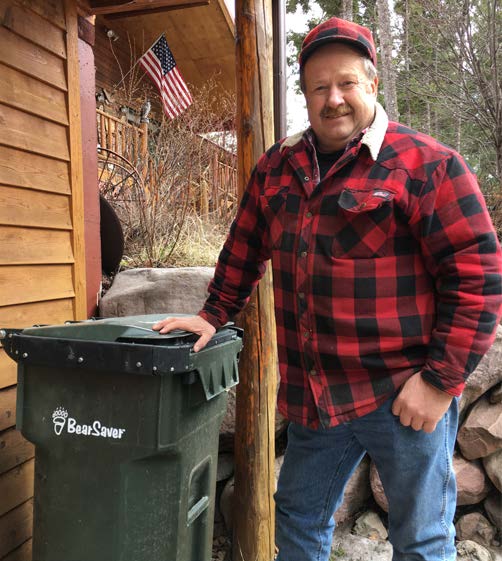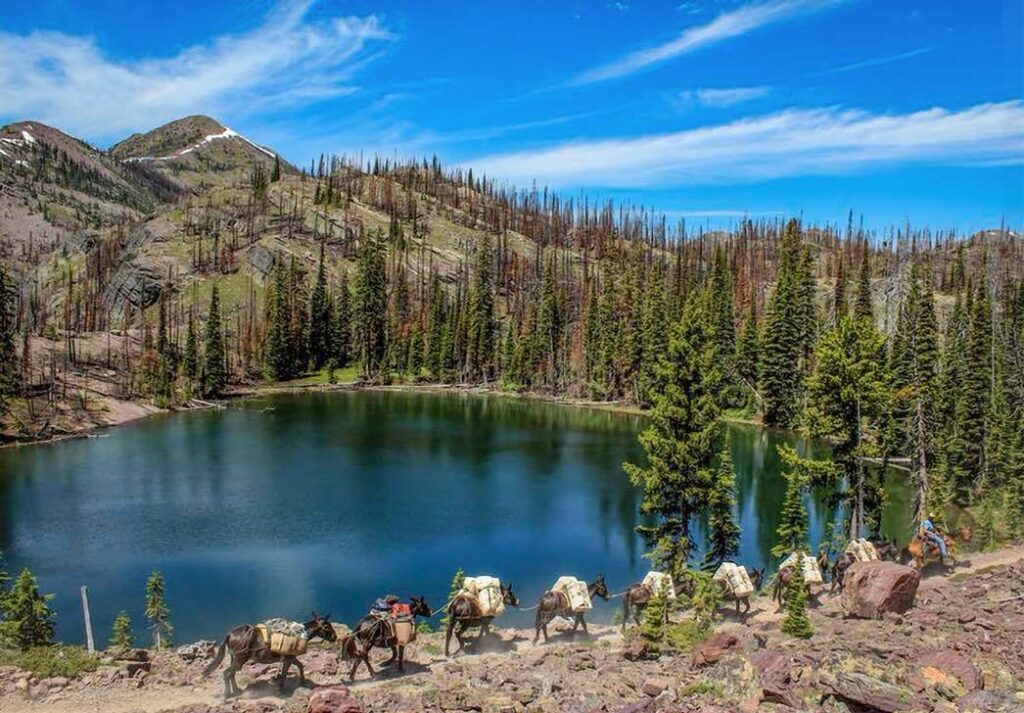Interview with Jack Rich of Rich’s Montana Guest Ranch
Interview by Seth Wilson
The following is excerpted from Carnivore Damage Prevention News, Issue 24. The complete edition is available online at www.cdpnews.net.
How did you start running backcountry trips?
Our family started in the guiding business beginning in 1946 and we were originally based near Yellowstone National Park. My father brought the operation to the Blackfoot Valley of Montana in 1958. We provide backcountry trips for clients who like to hunt, fish, hike and experience nature on horse-back. We have a permit with the United States Forest Service to operate our backcountry trips on public lands that are both national forest and designated wilderness areas. We’ve had that permit in use for 70 years now.
What do you offer your guests?
We operate with 60 or more horses and 24 pack mules that carry our gear. So, at any one time, we have 80 – 90 head of stock on the home ranch. We currently have ten year-round employees and another 12 – 14 during the summer season. On our wilderness pack trips we host up to ten guests with a crew of 4 – 5 for a maximum group size of 15 people. Back at the home ranch, we have 12 guest rooms and can accommodate up to 24 clients.

What is your conservation philosophy and where do carnivores fit into that?
Our core mission is about stewardship. We really believe in that and we are guided by Aldo Leopold’s writings from his book A Sand County Almanac: “We abuse land because we see it as a commodity belonging to us. When we see land as a community to which we belong, we may begin to use it with love and respect.” I believe that there are ‘Five fangs in the forest’. These are grizzly bears, black bears, wolves, mountain lions, and us. This makes up two broad ways to think about our place in the world and what we have to work with – both natural and cultural resources – we need both to be a good steward. Bears and wolves should not be vilified – they don’t need human attributes, they have instincts and we are now learning to live with them again. We used to have zero tolerance; now we realize that it all matters and the big challenge we face is to live with them. Our working ranch is where the rubber meets the road – where rural economies as an outfitting business can work in a place like this that has bears and wolves.
What types of precautions do you take when guiding clients in bear country?
First off, being on horseback is a huge advantage in terms of preventing negative encounters with bears. The horse itself helps to create a buffer and being on a horse makes you ‘larger than life’ to a bear. Simply being on a horse is a type of notification to both grizzly and black bears that people are in the forest. Group sizes are another important way we minimize problems with bears. We are almost always in groups of two or more. Typically, we have groups of 10 – 15 people and bears will know that a group of this size is coming and will avoid people.
What do you do when you encounter a bear on the trail?
First, we stop and assess the situation. We need to know is the bear a cub? Is it a mother bear? How is the bear behaving? Is the bear behaving normally? These are the types of questions we ask. We want to understand what the bear is doing, and we want to give the bear the chance to make the right decision. We want the bear to understand that we are a group of people. We always provide distance between people and the bear – and typically the bear will move on. For more than seven decades we’ve been in the backcountry with the bears and we have never had a single injury by a bear to our guests and we’ve never had to retaliate to a bear.

Might a horse bolt if it encounters a bear?
First off, there is an inherent risk whenever you travel outdoors on horseback. A horse’s instinct when it encounters potential danger is ‘flight or flee’ – to run from danger. It’s important to be prepared for that, especially if you are in heavy timber or places where you might surprise a bear. So, yes, there is risk. It’s really important to move cautiously on horseback when you are in tight trail situations, so you can let a bear know about your presence ahead of time and not scare the bear. It’s really about riding properly in bear country. You just need to be smart about it. We’ve never had a bear on the charge and we’ve never had our horses bolt. We’ve had bears come close to us and the bears have woofed and snorted, but we’ve never had the horses in a situation where they felt they needed to escape. We’ve been careful and prepared for more than 70 years and we had a good record so far.
Do you have an emergency plan for a bear attack?
We always carry bear spray but we’ve never had to use it. We do carry side-arms, but this is mainly for the unfortunate situation if we have to put one of our horses or mules down. We also have our side arms for a signal shot in case of an emergency. It’s a distant fourth reason for a bear. It would only be for a last resort.
How about when you are in a backcountry camp situation – what are your protocols?
We don’t tempt the bears. We keep a clean camp. We use bear resistant containers for everything – from our horse feed, human foods, anything that is an attractant. We have to account for the weight of the containers when we plan, but we always contain all foods that could otherwise attract a bear into our camp.
We also like to consolidate our ‘footprint’ when we are in a backcountry camp. In other words, we like to keep a smaller area that is designated for all activities – cooking, sleeping, and relaxing in camp. This helps let a bear know where all the activity is. We also always keep a person in camp if there are day trips going on and have never had a problem with a bear in our camps. Over all of these years we have moved our camps around in the backcountry and that helps. We talk about bears and we have safety talks but stress to clients that the risks are low. We are certainly ‘bear aware’ with our guests but we don’t want them to be bear paranoid.
What types of precautions do you take back at the home ranch?
We do everything we have in our power to not reward the bears with any type of food or other attractants, like garbage and livestock feed for our animals. We have secured our barns and food storage areas with bear doors, which deter bears from entering by reinforcing existing doors with a user-friendly sliding door. We also use bear resistant containers for all of our trash. If we see a bear that starts looking like it could cause problems, we contact the wildlife authorities for help. This might be if a bear initially ‘stands its ground’ instead of running away like they usually do. If that happens, it’s important to know if the bear might be protecting a carcass or a mother bear might have a cub nearby. Basically, I always try to understand the behavior of the bears so that we can give them enough space to leave and we don’t provoke them. We like having the bears here and we don’t want to be the cause of the demise of a bear. If we are the cause of that because of something we should have done, then shame on us.
